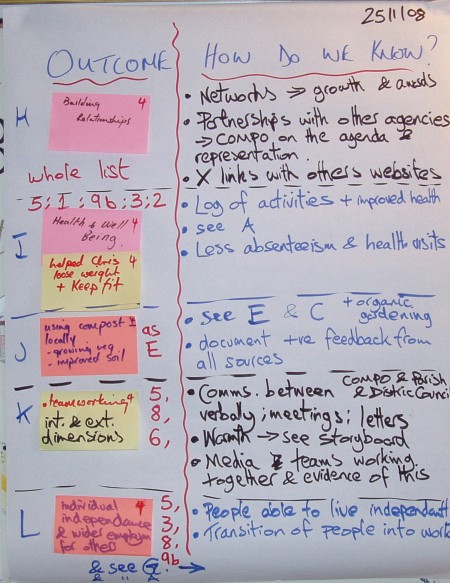Exercise 2: Stakeholder's Storyboard
Purpose
You can use this exercise to map how your project’s impact happens, this will mean that then you will be able to:
- Describe the story (hypothesis) of how the activities of a community composting project bring about not only the short-term results (outputs) but also the longer-term outcomes.
- Better engage with your stakeholder groups so that they are involved in the process of establishing criteria for success, as well as choosing targets and indicators that are meaningful to them.
- Take a step closer to understanding what needs to be measured in order that the story can best be told, and which measurement tools to choose (surveys, interviews etc.) that are fit for the purpose of proving it.
Preparation
Who to invite: Up to about 12 participants drawn from a selection of stakeholders who might be affected by or are able to affect the work of the community composting project. Ideally include people who have good knowledge of the project as well as those who would like to learn more, including potential or actual project partners (such as someone from the local authority, or the local school).
What to say to them: Invite them saying that this is the scoping stage for the project’s planning and evaluation. They will be part of an exercise in which they will be identifying the hoped-for outcomes of the project that are (or will be) most important to them as stakeholders, with a view in subsequent exercises to developing the ways of knowing (indicators) that will provide a better understanding of the project’s impact.
Role of facilitator:To welcome participants, guide them through the steps, keep them to time.
Materials needed: Chairs arranged in pairs or threes in sight of a large poster (2 x 2 A1 Flipchart sheets) showing the Storyboard template. Also you will need a flipchart stand, paper, marker pens, and plenty of Post-it notes.
When to use the exercise: As a stand alone exercise, the Storyboard is a good way of bringing people together who have a different (or little) experience of a project, so it can be a way of planning the detail, as well as communicating to new people what it is all about. As with Exercise 1 this exercise could be repeated with different groups over a period of time to include a wider range of stakeholders’ perspectives, and generate interest and buy-in from potential partners. As part of a formal evaluation process, it provides the material necessary to prepare an impact map and therefore make decisions about what is important to measure.
Which tools work together: As a minimum requirement for developing an evaluation framework, you should aim to undertake Exercises 2 and 3 as two parts of the same session with the same group of people.
Step by Step (Allow between 60 to 80 minutes)
- Make sure the invited workshop participants have a grasp of what the proposed (or existing) community composting project is about.
- In the light of that knowledge invite them to read through the eight questions in the left hand column of the table below.
Questions
Prompts
1. What is the context in which you are working that means you see value in running (or setting up) this community composting project?
You could describe the neighbourhood in which the project is situated area as it is now, and the local or wider need that you hope the project will address.
2. What are the activities that are undertaken (or planned) as part of the project?
These could include project planning, obtaining resources and involving people in different ways as well as delivering the physical elements of a project.
3. What initial results or changes have you seen (or would expect to see) as a result of these activities and actions?
“Changes” could be in the attitudes and behaviour of people affected by the project, as well as more visible, physical changes to the area.
4. What medium-term changes do you expect to see as a result of the project?
You could define “medium-term” as 8 to 16 months and define “long-term” as beyond 16 months from the project’s start date. However, this of course depends on the nature of the project.
At this stage focus on positive changes – but make a note of potential negative effects as part of Question 8 below.
5. What long-term changes do you expect to see as a result of the project?
6. How do the initial results (from Question 3 above) lead to the medium-term changes that you identified in response to Question 4?
Questions 6 and 7 present an opportunity to explore the assumptions that have been made that one change will automatically lead to another. To test the assumptions about those changes you need to be clear what else needs to happen or be part of the experience to make it so.
For example, just achieving a qualification may not be enough to ensure people get a job - perhaps some additional intervention, such as guidance on how to prepare for a job interview is needed to make this more likely to happen.
So try and describe precisely how each of the more immediate changes will lead to further changes in the future or for a wider group of people. Sometimes asking “Why is that important?” of each thing you mentioned in response to questions 3 and 4 can help with this.
7. How do the medium-term changes (from Question 4 above) lead to the longer-term changes that you identified in response to Question 5?
8. What challenges or barriers have you encountered (or foresee) in terms of: operational challenges; policy/regulation barriers; other issues?
This question is a useful opportunity for a reality check.
- Divide the group into pairs or threes and ask them to use the questions (and the prompts in the right hand column) as the basis for having a conversation about the project. Suggest that one person asks the questions and the others describe ‘their take’ on how the project works (or might work).
- Ask participants to record their responses to each of the questions on a separate post –it note, indicating the number of the question they are answering in the top left hand corner of the post-it note.
- Prepare a large poster, spread across 2 x 2 sheets of flipchart paper, copying the design illustrated below and attach it to the wall for all the participants to see.
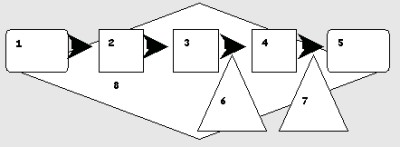
- Invite participants to attach the numbered post-it notes they have prepared to the appropriate boxes or triangles on the poster corresponding to the eight questions above.
- Once all post-it notes have been attached to the poster, bring people together to view (and where necessary, explain) their responses. Discuss the extent to which the completed Storyboard represents a true picture of how the project might have an impact.
- The completed Storyboard will provide a stepping-off point for building a formal Impact Map. It holds important information for deciding what to measure in order to provide evidence of impact as the project progresses.
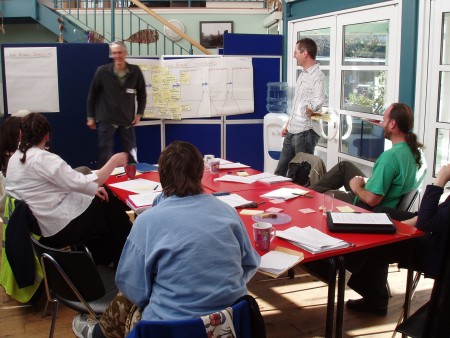
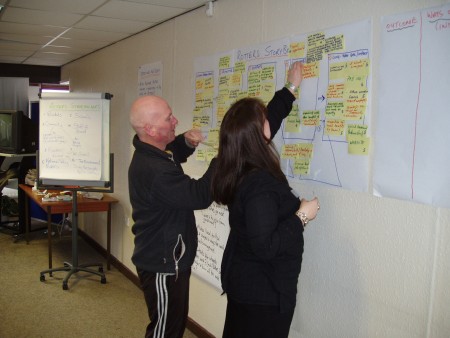
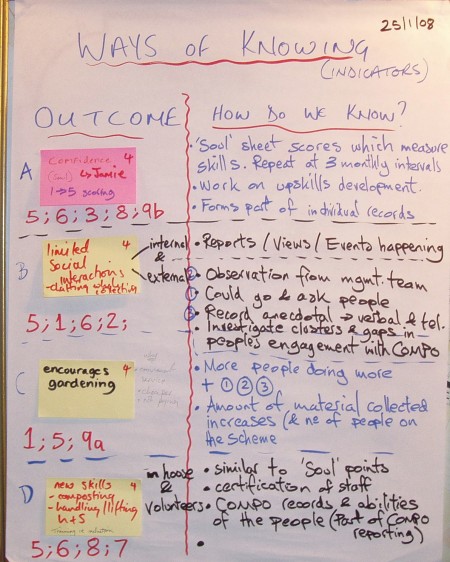
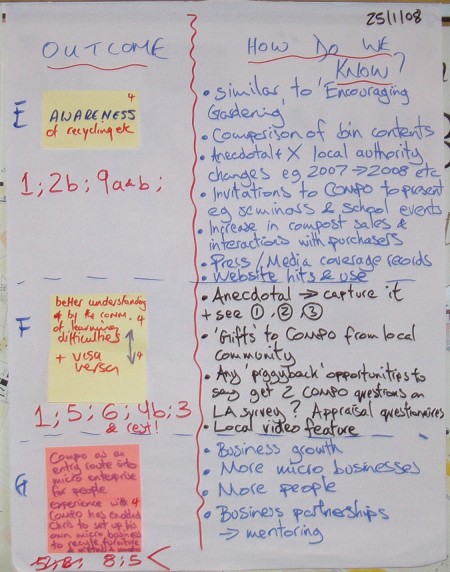
Printed from: www.valuingcommunitycomposting.org.uk
This website was developed as one of the deliverables for the Defra funded Open University research project, WR0211: Unlocking the Potential of Community Composting. Information contained in it is correct at the time of publication. © The Open University, January 2009



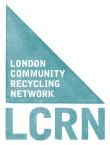
"We also need to work on changing public perception. This will only happen if people know what we do, because it is usually ignorance that causes the sniggers." Participant, Devon Workshop
"How great it was that you chose to work with Rotters for one of your round 2 stakeholder workshops. The organisation of the workshop was very well thought out, using the Storytelling – common themes." Rotters, Liverpool
"Breaking down all that Rotters is about into the Storyboard Template was extremely useful and a real eye opener in terms of how we can work more effectively within the local community." Rotters, Liverpool
"I really enjoyed Friday’s workshop… the methods used for measuring and discussion were excellent." Exeter Workshop Participant
